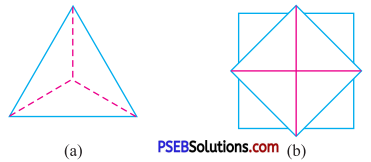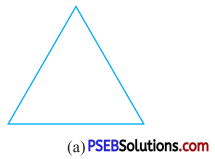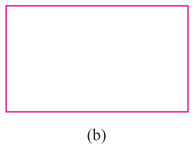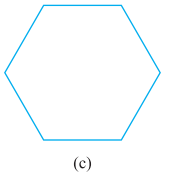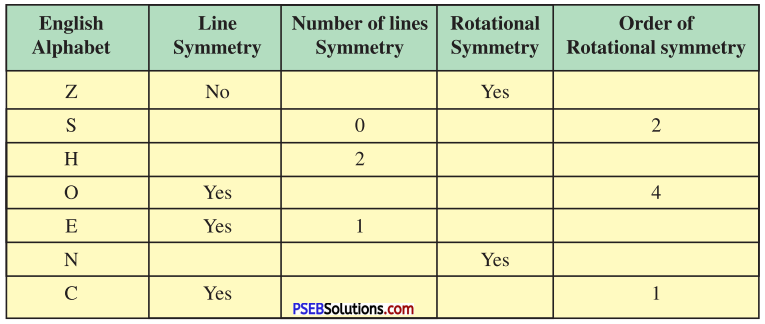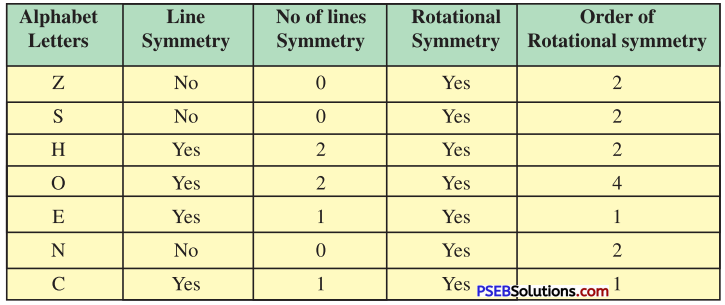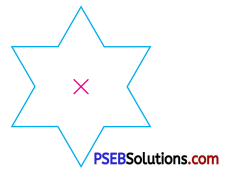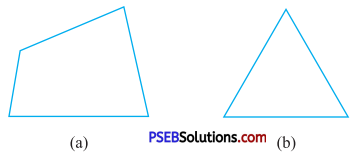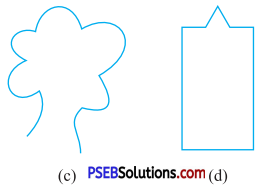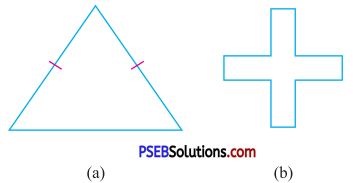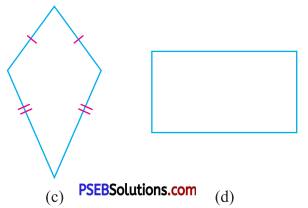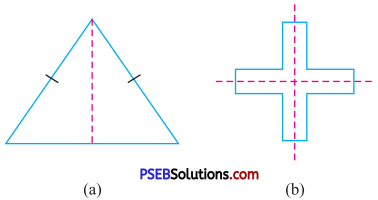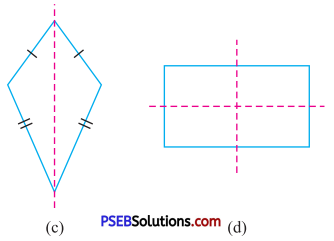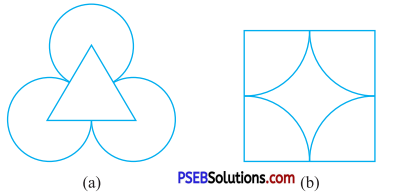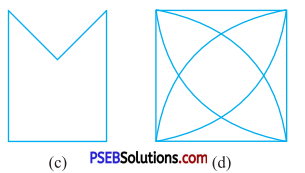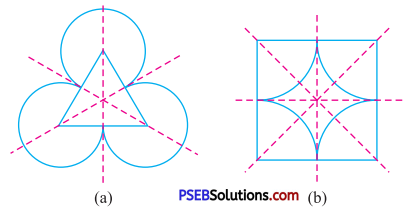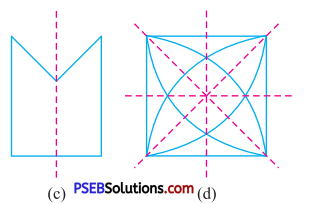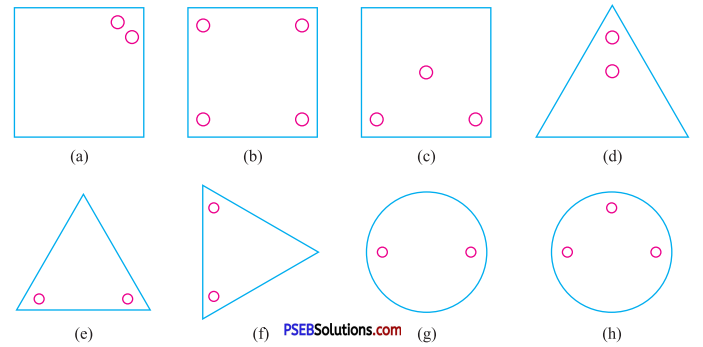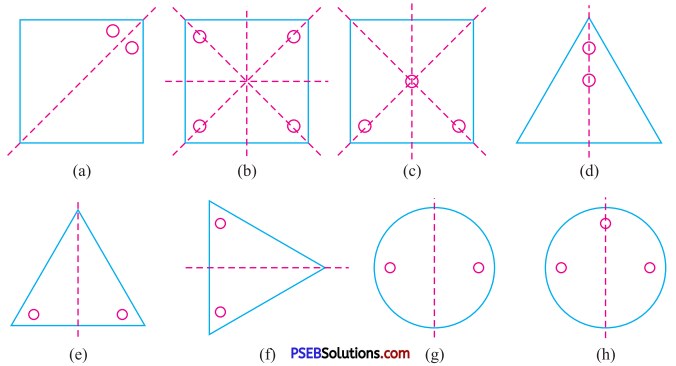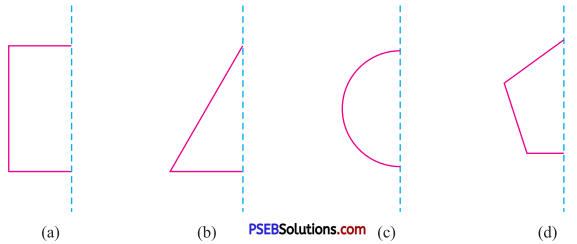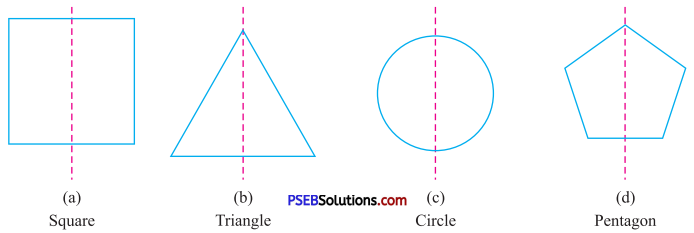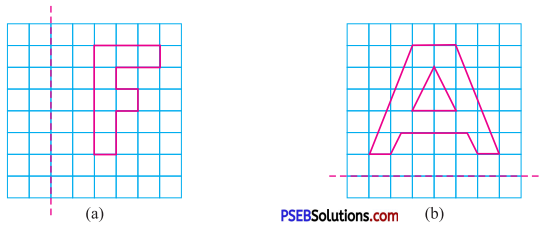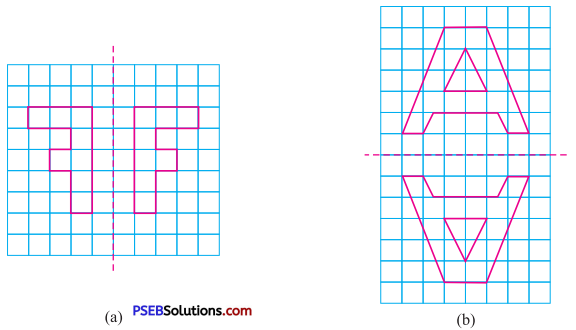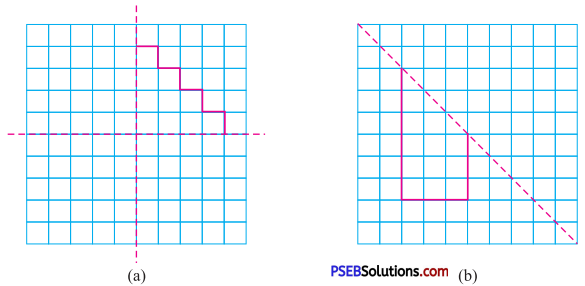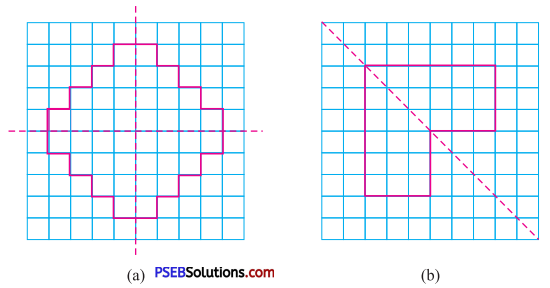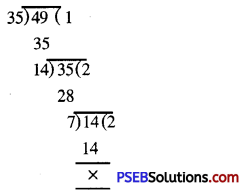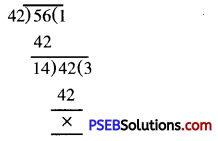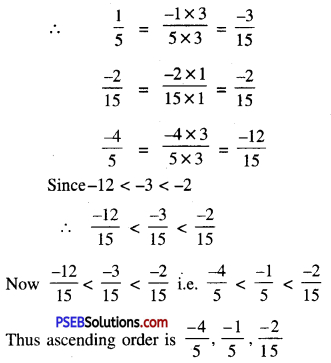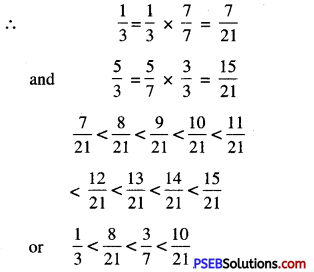Punjab State Board PSEB 7th Class Hindi Book Solutions Chapter 18 हिम्मती सुमेरा Textbook Exercise Questions and Answers.
PSEB Solutions for Class 7 Hindi Chapter 18 हिम्मती सुमेरा
Hindi Guide for Class 7 PSEB हिम्मती सुमेरा Textbook Questions and Answers
(क) भाषा-बोध
1. शब्दार्थ:
अद्भुत = विचित्र, हैरान करने वाली
ढेर सारी = बहुत अधिक
हिम्मत = साहस
मुश्किल = कठिन
माल = सामान
तय किया = निश्चय किया
चकित = हैरान
एकमात्र = इकलौती, सिर्फ एक
सिलसिला = क्रम
अजीब = विचित्र
मिन्नत = विनती, प्रार्थना
सर्र-से = तेज़ी से
फटकारना = डांटना
परिश्रम = मेहनत
कारोबार = व्यापार
2. इन मुहावरों के अर्थ समझते हुए वाक्यों में प्रयोग करें:
घुट्टी पिलाना ______________ _________________________
पत्थर की लकीर की तरह जमना ______________ _________________
सिर चकराना __________ __________________
धुन समाना _____________ ___________________
पीठ थपथपाना ________________ ____________________
उत्तर:
घुट्टी पिलाना (सिखाना-समझाना) – रोहित को न मालूम कैसी घुट्टी पिलाई गई थी कि माल की हेराफेरी करने में बड़ों-बड़ों को मात दे देता है।
पत्थर की लकीर की तरह जमना (पक्की तरह जमना) – मनुष्य की बुरी आदतें पत्थर की लकीर की तरह जमकर सारी जिंदगी उसका पीछा नहीं छोड़ती।
सिर चकराना (चक्कर आना) – गणित का प्रश्न-पत्र देखते ही कीमती लाल का सिर चकरा गया।
धुन समाना (लगन लगना) – रश्मि को तो आजकल गाना सीखने की धन समाई हई है।
पीठ थपथपाना (शाबाशी देना) – परीक्षा में प्रथम स्थान प्राप्त करने पर प्रधानाचार्य ने नकुल की पीठ थपथपाई।
![]()
3. पर्यायवाची शब्द लिखें:
पिता = ………………….
राजा = ……………….
आदमी = …………………
दुनिया = …………………..
कहानी = ……………..
हिम्मत = …………………
मुसीबत = ………………..
उत्तर:
शब्द पर्यायवाची शब्द
पिता = जनक, तात
राजा = अधिपति, राजन
आदमी = मनुष्य, मानव
दुनिया = संसार, जगत
कहानी = कथा, गल्प
हिम्मत = शक्ति, साहस
मुसीबत = संकट, विपत्ति
4. विपरीत अर्थ वाले शब्द लिखें:
सवेरा = ………………..
गरीब = ……………….
उधार = ……………….
इनाम = ……………….
प्यार = ………………..
बेचना = ………………..
रोना = ……………..
न्याय = ………………….
विदा = ………………….
उत्तर:
शब्द विपरीत शब्द
सवेरा = सांझ
गरीब = अमीर
उधार = नकद
इनाम = सज़ा
प्यार = नफ़रत
बेचना = खरीदना
रोना = हँसना
न्याय = अन्याय
विदा = स्वागत
5. इन समरूपी भिन्नार्थक शब्दों के अर्थ लिखकर वाक्यों में प्रयोग करें:
(1) समान = ………………
सामान = ………………
(2) ओर = ………………….
और = ……………..
(3) दिन = ………………..
दीन = ……………….
(4) उदार = ………………
उधार = ………………
उत्तर:
(1) समान = बराबर-हमें शहीद भगत सिंह के समान देशभक्त बनना चाहिए।
सामान = सामग्री- सीमा सिलाई-कढ़ाई की सामग्री लेने बाज़ार गई है।
(2) ओर – तरफ- आप किस ओर जा रहे हैं?
और = अधिक – राम को थोड़ी और खीर दो।
(3) दिन = दिवस – हमारे विद्यालय में आज शहीदी दिन मनाया गया।
दीन = ग़रीब – कभी भी दीन को नहीं सताना चाहिए।
(4) उदार = दाता – ईश्वर अपने भक्तों पर सदा उदार रहता है।
उधार = कर्ज – कभी भी उधार का मत खाओ।
6. इन वाक्यों में रेखांकित शब्द भाववाचक संज्ञा है या विशेषण
- चोरी से बढ़कर कोई पाप दुनिया में नहीं है।
- सुमेरा के नन्हें मन में यह बात बैठ गई थी।
- सुमेरा हिम्मती बालक था।
- ड्राइवर की फटकार का कोई असर नहीं हुआ।
- सुमेरा की कहानी काल्पनिक नहीं है।
- सुमेरा ने कमेटी वालों को दो रुपए नहीं दिए।
उत्तर:
- भाववाचक संज्ञा
- विशेषण
- भाववाचक संज्ञा
- भाववाचक संज्ञा
- विशेषण
- विशेषण
7. प्रयोगात्मक व्याकरण
(1) सुमेश ने शाम को खाना बनाया।
(2) मैं यहाँ से नहीं हिलूँगा।
(3) वह जोर-जोर से आवाजें लगा रहा था।
(4) उसके लिए इतना ही काफ़ी है।
उपर्युक्त पहले वाक्य में शाम को शब्द क्रिया के काल का बोध करा रहा है। दूसरे वाक्य में यहाँ शब्द क्रिया के स्थान का बोध करा रहा है। तीसरे वाक्य में ज़ोर-ज़ोर शब्द क्रिया होने की रीति (ढंग) का बोध करा रहा है तथा चौथे वाक्य में इतना शब्द क्रिया की मात्रा का बोध करा रहा है। अतः ये सभी शब्द (शाम को, यहाँ, ज़ोर-ज़ोर तथा इतना) क्रिया की विशेषता बता रहे हैं। अतएव ये शब्द क्रियाविशेषण हैं।
जो शब्द क्रिया की विशेषता को बताते हैं, उन्हें क्रियाविशेषण कहते हैं। क्रिया विशेषण के चार भेद हैं-कालवाचक क्रियाविशेषण, स्थानवाचक क्रिया विशेषण, रीतिवाचक क्रिया विशेषण, परिमाणवाचक क्रियाविशेषण।
इस पाठ में क्रियाविशेषण के पहले दो भेदों के बारे में बताया जा रहा है।
(1) वह सवेरे-सवेरे जाकर सब्जी वालों के बीच बैठ गया।
(2) वह शाम को पढ़ने जाता है।
उपर्युक्त वाक्यों में सवेरे-सवेरे तथा शाम को शब्दों से क्रिया के काल की विशेषता का पता चलता है। इसलिए ये कालवाचक क्रियाविशेषण है। अतएव जिन शब्दों से क्रिया के होने के समय का पता चले, उन्हें कालवाचक क्रिया विशेषण कहते हैं। अन्य कालवाचक क्रिया विशेषण शब्द:- आज, कल, परसों, अब, जब, तब, तभी, पहले, बाद में, आजकल, प्रतिदिन, रात को, पाँच बजे, हर साल, नित्य हमेशा, महीनों, वर्षों, बहुधा, हर घड़ी, सायं, प्रातःकाल।
(1) सब्जी बाज़ार पास ही था।
(2) वह इधर-उधर माल ढोता है।
उपर्युक्त वाक्यों में पास तथा इधर-उधर शब्दों से क्रिया के स्थान की विशेषता का पता चलता है। इसलिए ये स्थानवाचक क्रियाविशेषण है।
अतएव जिन शब्दों से क्रिया के स्थान का पता चले, उन्हें स्थानवाचक क्रियाविशेषण कहते हैं।
अन्य स्थानवाचक क्रिया विशेषण शब्द:- जहाँ, किधर, जिधर, नीचे, ऊपर, सामने, दाहिने, बाएं, दाएं, उस ओर, अन्यत्र, दूर, चारों तरफ, एक तरफ, आगे, पीछे।
(ख) विचार-बोध
1. इन प्रश्नों के उत्तर एक या दो वाक्यों में लिखें:
प्रश्न 1.
सुमेरा कैसा बालक था ?
उत्तर:
सुमेरा एक मामूली-सा गरीब बालक था।
प्रश्न 2.
उसके पिता ने बचपन से ही उसे कैसी घुट्टी पिलायी थी ?
उत्तर:
सुमेरा को उसके पिता ने बचपन से ही सच्चाई और ईमानदारी की घुट्टी पिलायी थी।
प्रश्न 3.
उसके पिता को कौन-सी बीमारी हो गई थी ?
उत्तर:
सुमेरा के पिता को लकवा मार गया था।
प्रश्न 4.
सुमेरा ने किससे रुपए उधार माँगे?
उत्तर:
सुमेरा ने अपने मास्टर जी से रुपए उधार माँगे थे।
प्रश्न 5.
सुमेरा से दो रुपए किसने माँगे ?
उत्तर:
साइकिल पर थैला लटकाए कमेटी के आदमी ने सुमेरा से दो रुपए माँगे थे।
प्रश्न 6.
राजनिवास में कौन रहते थे ?
उत्तर:
राजनिवास में दिल्ली का राजा रहता था।
प्रश्न 7.
राजा साहब ने सुमेरा की हिम्मत को देखकर कितने रुपए दिए ?
उत्तर:
राजा साहब ने सुमेरा की हिम्मत को देखकर उसे दस रुपए इनाम में दिए।
![]()
2. इन प्रश्नों के उत्तर चार या पाँच वाक्यों में लिखें:
प्रश्न 1.
सुमेरा के चरित्र की विशेषताएँ लिखें।
उत्तर:
- सुमेरा एक मामूली-सा गरीब बालक है।
- उसे पढ़ने में बहुत रुचि है।
- वह बहुत हिम्मती, ईमानदार, सच्चा तथा लगन का पक्का बालक है।
- पिता के लकवा से बीमार हो जाने पर भी वह अपना साहस नहीं छोड़ता तथा फल बेच कर घर का खर्चा चलाता है और अपनी पढ़ाई भी जारी रखता है।
- अपनी मेहनत के बल पर वह अपने पिता का इलाज करता है, पढ़ाई करते हुए कॉलेज तक जाता है, मकान बनवाता है और दुकान भी बना लेता है।
प्रश्न 2.
उसने अपना और अपने पिता का पेट भरने के लिए क्या काम किया ?
उत्तर:
सुमेरा ने अपना और अपने पिता का पेट भरने के लिए अपने स्कूल के मास्टर जी से तीस रुपए ले कर मंडी से संतरे खरीदे और उन्हें बेच कर छत्तीस रुपए कमाए। इनमें से एक रुपया कर्ज उतारने के लिए रखकर, पाँच रुपए का घर के लिए आटा दाल लाया तथा तीस रुपए अगले दिन फल खरीदकर बेचने के लिए रख दिए।
प्रश्न 3.
दूसरे दिन शाम को कौन-सी अजीब बात हो गई ?
उत्तर:
दूसरे दिन शाम को साइकिल के हैंडल पर थैला लटकाए एक आदमी हर ठेले वाले के पास जाता और इशारों में बात करता और उसके थैले में ठेले वाला कुछ डाल देता। वह साइकिल वाला सुमेरा के पास आकर खड़ा हुआ तो सुमेरा कुछ नहीं समझा। उसके साथ वाले ने उसे थैले में दो रुपए डालने के लिए कहा, पर उसने नहीं डाले क्योंकि वह मुफ्त में उसे कुछ नहीं देना चाहता था।
प्रश्न 4.
वह राजा साहब से मिलने में किस प्रकार सफल हुआ?
उत्तर:
सुमेरा का सामान जब कमेटी वाले उठा कर ले गए तो वह राजा साहब से मिलने गया, पर पहरेदारों ने उसे नहीं मिलने दिया। वह बाहर खड़ा राजा साहब के बाहर आने की प्रतीक्षा करने लगा। वे बड़ी-सी गाड़ी में बाहर निकले और गाड़ी सर्र-से निकल गई। सुमेरा उनसे नहीं मिल पाया। वह वहीं बैठकर उन के लौटने की राह देखने लगा। शाम को उस ने राजा साहब की गाड़ी आती हुई देखी तो सड़क के बीच में दोनों हाथ फैला कर उनकी गाड़ी के सामने खड़ा हो गया तो ड्राइवर ने गाड़ी रोककर उसे डांटा पर वह राजा साहब की खिड़की के पास जाकर अपनी बात कहने लगा तो उन्होंने उसे कोठी के अन्दर आने के लिए कहा। इस प्रकार वह राजा साहब से मिलने में सफल हुआ।
प्रश्न 5.
राजा साहब ने सुमेरा की क्या सहायता की ?
उत्तर:
राजा साहब ने उस की आप बीती सुन कर उसकी हिम्मत की तारीफ़ करते हुए उसे दस रुपए इनाम दिए और अगले दिन आने के लिए कहा। अगले दिन जब वह फिर राजा साहब से मिलने गया तो उन्होंने उसे लाइसेंस दिलवा दिया और साथ में उसे एक सौ रुपए भी दिए, जिस से वह अपना काम शुरू कर सके। उन्होंने उसे एक महीने बाद फिर आकर अपने काम-काज की खबर देने के लिए भी कहा।
प्रश्न 6.
सुमेरा की जगह आप होते तो क्या करते ?
उत्तर:
सुमेरा की जगह यदि मैं होता तो अपने बीमार पिता की सेवा करने के लिए कोई भी काम करता तथा जब समय मिलता अपनी पढ़ाई भी जारी रखता। यदि काम करते हुए मुझे कोई बेईमानी करने अथवा झूठ बोलने के लिए कहता तो मैं उसका विरोध करता और अपने जैसे अन्य साथियों के साथ मिलकर उच्च अधिकारियों तक अपनी बात पहुँचाता जिस से हमारे जैसे बाल श्रमिकों पर अत्याचार न हो सकें।
प्रश्न 7.
यदि सुमेरा के पिता को लकवा न होता तो उसका जीवन कैसा होता ? सोचें और लिखें।
उत्तर:
यदि सुमेरा के पिता जी को लकवा न होता तो सुमेरा को इतना अधिक संघर्ष नहीं करना पड़ता। सुमेरा पढ़ने में बहुत अच्छा था। उसके अध्यापक भी उसे प्यार करते थे जैसा कि इसी बात से स्पष्ट है कि वह फल बेचने के लिए उधार अपने मास्टर जी से ही लेता है। वह पढ़-लिखकर अच्छी डिग्री प्राप्त कर कहीं अच्छी नौकरी प्राप्त कर लेता। वह अपनी ईमानदारी और सच्चाई के बल पर उन्नति करते हुए साफ-सुथरा प्रशासन देश को देता है।
प्रश्न 8.
कमेटी के लोग इसी प्रकार फड़ी-रेहड़ी वालों से मनमाना टैक्स वसूलते हैं जो कि कमेटी वालों के लिए उचित है परन्तु रेहड़ी वालों के लिए अनुचित, आप ऐसे लोगों के बारे में क्या सुझाव देंगे ?
उत्तर:
कमेटी वाले लोगों का इस प्रकार बेईमानी से पैसा वसूल करना कमेटी के लिए नुकसानदेह है क्योंकि यह पैसा कमेटी के खाते में जमा नहीं होता बल्कि ऊपर की काली कमाई होती है, जिससे भ्रष्टाचार फैलता है। फड़ीवालों के लिए भी इस प्रकार रिश्वत देना ठीक नहीं है, उन्हें कमेटी से लाइसेंस लेना चाहिए तथा ऐसे कालाबाज़ारियों की उच्च अधिकारियों से शिकायत करनी चाहिए।
प्रश्न 9.
अपने जीवन में घटित किसी ऐसी घटना का वर्णन करो जब आपने साहस का परिचय दिया हो।
उत्तर:
एक दिन मैं विद्यालय जा रही थी। अचानक मैंने देखा कि एक वृद्ध व्यक्ति सड़क पार कर रहा था और कांप भी रहा था। दूसरी ओर से तेज़ रफ्तार से एक कार आ रही थी और पीछे से एक बैल बेकाबू हो कर दौड़ता आ रहा था। मुझे लगा कि कहीं बाबा जी गिर न पड़ें। मैंने पल-भर सोचा और अपना बस्ता पास में फुटपाथ पर रखकर दौड़कर उन्हें पकड़ कर सड़क के पार ले गई। तभी तेज़ कार से दौड़कर आते हुए बैल की टक्कर हो गई। मैं और बाबा जी बच गए थे पर हम दोनों हाँफ रहे थे।
(ग) आत्म-बोध
साहसी व्यक्तियों की कहानियाँ पढ़ो और उनके गुणों को जीवन में अपनाओ।
PSEB 7th Class Hindi Guide हिम्मती सुमेरा Important Questions and Answers
1 .निम्नलिखित प्रश्नों के उत्तर उचित विकल्प चुनकर लिखिए
प्रश्न 1.
सुमेरा सफल होकर क्या बना ?
(क) व्यापारी
(ख) अध्यापक
(ग) चित्रकार
(घ) लेखक
उत्तर:
(क) व्यापारी
प्रश्न 2.
सुमेरा कैसा बस्ता लेकर पढ़ने जाता था ?
(क) नया
(ख) पुराना
(ग) महँगा
(घ) स्टाइलिश
उत्तर:
(ख) पुराना
प्रश्न 3.
सुमेरा ने मंडी से क्या खरीदा था ?
(क) संतरे
(ख) अमरूद
(ग) आम
(घ) सेब
उत्तर:
(क) संतरे
प्रश्न 4.
सुमेरा को तीस रुपए किसने दिए थे ?
(क) दोस्त ने
(ख) पड़ोसी ने
(ग) पिता जी ने
(घ) मास्टर जी ने
उत्तर:
(घ) मास्टर जी ने
प्रश्न 5.
राजा साहब ने सुमेरा को कितने रुपए दिए थे ?
(क) दस रुपए
(ख) बीस रुपए
(ग) तीस रुपए
(घ) चालीस रुपए
उत्तर:
(क) दस रुपए
2. निम्नलिखित रिक्त स्थानों की पूर्ति उचित विकल्पों से कीजिए
प्रश्न 1.
सुमेरा की माँ की ………………… हो गई थी।
(क) मृत्यु
(ख) पदोन्नति
(ग) तबादला
(घ) बीमारी
उत्तर:
(क) मृत्यु
![]()
प्रश्न 2.
सुमेरा के पिता ………………. पर सामान ढोने का काम करते थे।
(क) रेलवे स्टेशन
(ख) बस अड्डे
(ग) ऑटो स्टैंड
(घ) रिक्शा स्टैंड
उत्तर
(ख) बस अड्डे।
प्रश्न 3.
सुमेरा के पिता ………………… बेहोश रहे।
(क) चार दिन
(ख) पाँच दिन
(ग) दो दिन
(ग) तीन दिन
उत्तर:
(ग) दो दिन
प्रश्न 4.
शाम तक सुमेरा ने ……….. रुपए के संतरे बेच लिए थे।
(क) 36
(ख) 24
(ग) 35
(घ) 39
उत्तर:
(क) 36
प्रश्न 5.
सुमेरा ने दिल्ली के सब्जी बाज़ार में अपनी ………. बना ली।
(क) साइकिल
(ख) दुकान
(ग) मोटर
(घ) क और ग
उत्तर:
(ख) दुकान
3. दिए गए शब्द का सही अर्थ से मिलान कीजिए
प्रश्न 1.
विषमता:
विषैला
भेदभाव
विषम
उत्तर:
भेदभाव
प्रश्न 2.
कड़ी:
सख्त
नरम
गरम
उत्तर:
सख्त
प्रश्न 3.
लाज:
शेखर
शर्म
लता
उत्तर:
शर्म
प्रश्न 4.
दूनी:
दुगुना
देना द्वारा
उत्तर:
दुगुना
हिम्मती सुमेरा Summary
हिम्मती सुमेरा पाठ का सार
‘हिम्मती सुमेरा’ एक ऐसे गरीब बालक की कहानी है जो अपनी मेहनत और लगन से एक सफल व्यापारी बन गया। सुमेरा पुराने से बस्ते को लेकर पढ़ने स्कूल जाता है। उसकी माँ की मृत्यु हो गई है तथा पिता बस अड्डे पर सामान ढोने का काम करता है। पिता उसे सच्चाई और ईमानदारी के रास्ते पर चलने की शिक्षा देते हैं। एक दिन शाम को सुमेरा घर का काम-काज करने के बाद पढ़ रहा था कि तीन-चार आदमी उसके पिता को उठा कर लाए जो सिर चकराने से बेहोश हो गए थे। उन्हें अस्पताल ले जाया गया। जहाँ वे दो दिन बेहोश रहे। बेहोशी टूटने पर पता चला कि उन के दोनों पैरों को लकवा मार गया था। दस वर्षीय सुमेरा समझ नहीं रहा था कि अब क्या करें?
सुमेरा ने दिन में स्कूल, सुबह पिता की सेवा और बाकी समय में सब्जी बेचने का निश्चय किया। उसके पास पैसे नहीं थे। उसने अपनी सारी दशा अपने मास्टर जी को बताई तो उन्होंने उसे तीस रुपए उसकी हिम्मत से खुश होकर इनाम में दिए परन्तु सुमेरा ने इन्हें उधार समझकर लौटाने के लिए कहा। सुमेरा ने मंडी से तीस रुपए के संतरे खरीदे और सवेरे-सवेरे सब्जी वालों के बीच में उन्हें गा-गा कर बेचता रहा। शाम तक उसने छत्तीस रुपए के संतरे बेच लिए तथा बचे हुए चार संतरे वह पिता के खाने के लिए ले आया। अगले दिन फिर उसने यही किया। उसकी बिक्री ठीक हो रही थी कि शाम को साइकिल पर थैला लटकाए कोई वसूला करने आया। पास वाले ने उसे साइकिल वाले के थैले में दो रुपए डालने के लिए कहा पर उसने नहीं डाले। दो दिन बाद कमेटी की गाड़ी आई और उस का सामान उठा कर ले गए क्योंकि उस के पास लाइसेंस नहीं था।
सवेरा होने पर वह दिल्ली के राजा के घर गया पर पहेरदारों ने उसे अन्दर नहीं जाने दिया। वह वही बैठा रहा। राजा बड़ी-सी मोटर में बाहर निकला पर सुमेरा के वहाँ तक पहुँचने से पहले ही गाड़ी वहाँ से निकल गई। सुमेरा वहीं बैठकर राजा के लौटने की प्रतीक्षा करने लगा। शाम को राजा की गाड़ी आते देख वह दोनों हाथ फैलाकर सड़क के बीच में राजा की गाड़ी के सामने खड़ा हो गया। गाड़ी रोककर ड्राइवर ने उसे डाँटा तो वह राजा साहब की खिड़की के सामने कुछ कह कर सुबकने लगा। तब राजा साहब ने उसे कोठी में बुलाकर सब कुछ पूछा और सुमेरा को दस रुपए देकर अगले दिन आने के लिए कहा। अगले दिन राजा साहब ने उसे लाइसेंस और सौ रुपए दिए कि इन से वह अपना काम शुरू करे। सुमेरा ने कठिन परिश्रम से अपना काम बढ़ाया, पिता का इलाज कराया, उन्हें दुकान पर बैठा कर वह पढ़ने जाता। उसने दो कमरों का पक्का मकान और दिल्ली के सब्जी बाज़ार में अपनी दुकान भी बना ली।
